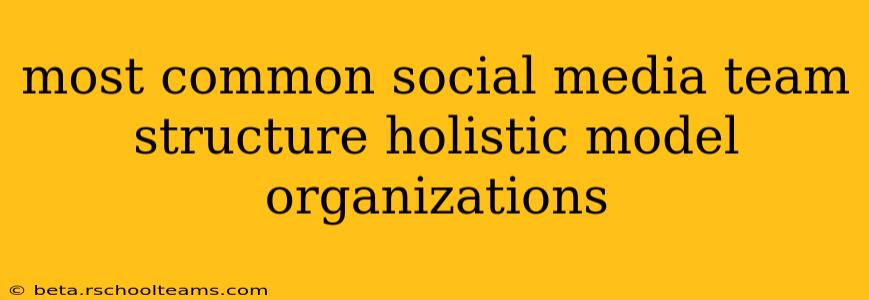In today's digital landscape, a robust social media presence is crucial for organizations of all sizes. But effectively managing this presence requires a well-structured team. While the ideal structure depends heavily on the organization's size, resources, and goals, several common models have emerged, particularly within holistic organizations prioritizing integrated marketing and communication. This article explores these common structures and addresses frequently asked questions.
What are the different types of social media team structures?
Several social media team structures cater to different organizational needs. These include:
-
Centralized: A single team manages all social media activity across the organization. This offers consistency in branding and messaging but might struggle to adapt to niche audience needs in diverse departments.
-
Decentralized: Individual departments or business units manage their own social media accounts. This allows for tailored content and faster response times but risks inconsistencies in brand voice and messaging.
-
Hybrid: A blend of centralized and decentralized structures, offering the benefits of both. A central team establishes brand guidelines and provides support, while individual departments manage their specific accounts. This is frequently the most effective approach for larger, more complex organizations.
-
Agency-led: Outsourcing social media management to a specialized agency. This can provide expertise and resources but requires careful management of communication and alignment with organizational goals.
What is the best social media team structure for a small business?
For small businesses, a centralized structure often works best, with one or two individuals handling all social media activities. This ensures consistency and allows for a deep understanding of the overall brand voice. As the business grows, a hybrid approach might be considered to maintain efficiency and consistency while allowing for more focused content.
How do I structure a social media team for a large organization?
Large organizations often benefit from a hybrid structure. A central team develops the overall social media strategy, establishes brand guidelines, and provides training and support to departmental teams. Individual departments then manage their own social media accounts, allowing for tailored content and responsiveness to specific audiences. This structure necessitates robust communication channels and clear reporting mechanisms.
What are the key roles in a social media team?
Regardless of the chosen structure, a successful social media team typically includes roles such as:
- Social Media Manager: Oversees the overall strategy, sets goals, and manages the team.
- Content Creator: Develops engaging written, visual, and video content.
- Community Manager: Engages with the audience, responds to comments and messages, and builds relationships.
- Social Media Analyst: Tracks performance, analyzes data, and provides insights to inform strategy.
- Social Media Designer: Creates visually appealing graphics and designs for social media posts. (Often integrated into the Content Creator role in smaller teams)
What are the challenges of managing a social media team?
Managing a social media team presents various challenges, including:
- Maintaining Brand Consistency: Ensuring all social media activity reflects the organization's brand values and messaging.
- Measuring ROI: Demonstrating the value of social media efforts through clear metrics and reporting.
- Keeping up with Trends: Staying current with evolving social media platforms and algorithms.
- Managing Multiple Platforms: Effectively managing content across various platforms with unique requirements.
- Dealing with Negative Feedback: Responding professionally and effectively to critical comments and negative reviews.
How can I improve my social media team's performance?
To enhance your social media team's performance:
- Invest in Training: Provide regular training on new tools, platforms, and best practices.
- Establish Clear Goals and Metrics: Define measurable objectives and track performance against those goals.
- Foster Collaboration: Encourage communication and collaboration within the team and across departments.
- Use Social Media Management Tools: Leverage tools to streamline workflows and improve efficiency.
- Regularly Review and Adapt Strategy: Continuously assess performance and make adjustments to the strategy as needed.
By understanding the different social media team structures and addressing potential challenges proactively, organizations can create a high-performing team that drives engagement, builds brand awareness, and achieves its business objectives. The key is to find the structure that best aligns with the organization's unique needs and resources, fostering a collaborative and results-oriented environment.
